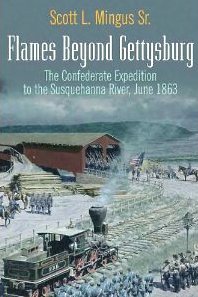|
Flames Beyond Gettysburg certainly does
deserve a place in the Gettysburg library of any serious judge of the facts
underpinning the Gettysburg Campaign. Written by Scott L. Mingus, Sr., the book
provides a well-written picture of the Confederate advance into Pennsylvania, beginning with Richard Ewell’s corps reaching Carlisle and ending with John
Gordon’s brigade of Jubal Early’s division arriving at Wrightsville. Most
importantly Mr. Mingus documents the rain fall that occurred over a period of
several days during the Confederate march, and gives close details of the
movements of the cavalry squadrons that accompanied Early and Ewell’s separate
marches toward the Susquehanna; details important to any critical analysis of
Lee’s objective in moving into Pennsylvania. corps reaching Carlisle and ending with John
Gordon’s brigade of Jubal Early’s division arriving at Wrightsville. Most
importantly Mr. Mingus documents the rain fall that occurred over a period of
several days during the Confederate march, and gives close details of the
movements of the cavalry squadrons that accompanied Early and Ewell’s separate
marches toward the Susquehanna; details important to any critical analysis of
Lee’s objective in moving into Pennsylvania.
However, in bringing these important details into clear
view, Mr. Mingus failed to seize the opportunity to use them to debunk the
historical myth that General Lee’s intent, in carrying the war into Pennsylvania, was merely to threaten the seizure of Harrisburg while sweeping up as much
moveable wealth of the State that he could, before returning to Virginia.
The missed opportunity is manifest in Mr. Mingus’s choice of
subtitle: “The Confederate Expedition to the Susquehanna River.” The
word “expedition” is defined by Webster’s to mean “a sending forth of
men on the march for some definite purpose.” As do historians and civil war
writers generally, Mr. Mingus identifies the purpose of Lee’s march into Pennsylvania to be the capture of Harrisburg, writing that Lee meant to “push well beyond Maryland into the lush Pennsylvania farmlands, forcing the Army of the Potomac to come to
[him]. [His] eyes were on targets of political and strategic importance, among
them Harrisburg.”
Mingus offers the explanation that Lee was motivated by this
purpose, because the “seizure of the capital of the North’s second most
populous state could stimulate cries for a negotiated peace and increase
European pressure on Washington.” Yet, when one uses common sense to analyze
the objective strategic situation confronting Lee and the Confederacy, in June
1863, such an explanation is easily seen to be silly indeed. For Vicksburg was
about to fall to Grant’s siege and the Northern people could hardly be expected
under such circumstance to cry for a negotiated peace; nor could the British
government—the only foreign government that mattered—seriously be expected to
exert the only meaningful “pressure” that counted, the British Navy, against
Lincoln’s now effective blockade.
Mingus hints at another purpose Lee might have had in mind
when in a throwaway sentence he writes, “Surely Hooker’s army would follow Lee.
. . . If Lee was correct (in thinking this), he could, at the time and place of
his choosing, [initiate] a pitched battle.” Shying away from analyzing
the facts in light of this quite different purpose, the author concentrates the
reader’s attention on the details of Early’s march from Cashtown to York and then Gordon’s march on to Wrightsville. In the process of this, for proof of
Lee’s motive, the story relies on the writings that obscure the objective truth
of the matter. For example, as do most historians writing about the campaign,
the author, here, refers the reader to the message that time has preserved,
sent by General Lee to Ewell on June 22, 1863, as Ewell was crossing the Potomac. “I think,” Lee wrote, “your best course will be toward the Susquehanna. . . If Harrisburg comes within your means, capture it.”
Apparently loath to separate from the pack of historians who
cling to Lee’s phrase, the author means this shopworn citation to form the
primary basis for proving the fact of Lee’s intent. Yet, given the undisputed reality
of the matter all one can say about Lee’s statement is that it was
intended to mislead the enemy in the event the courier carrying the message was
seized in route to Ewell. For everyone must agree General Lee was not stupid.
He had to know—as any reasonable person under the circumstances had to
know—that it was impossible for Ewell’s corps, much less Lee’s whole
army, to “capture” Harrisburg.
Why? Because, as Mr. Mingus must well know, the Susquehanna River, in June 1863, was impossible to cross without a bridge; and there
certainly would not be a bridge by the time either Rodes’s division reached the
river in front of Harrisburg, or Gordon’s brigade reached the river in front of
Columbia! The historical depth charts for the river at these points is available
to anyone who cares to read them.

Historically, one might wade across the mile wide river at
either point in the fall of the year, but never in the history of recorded time
during June. Mr. Mingus, in the substantial part of his book, confirms this
fact when he writes: “Gordon realized there was no alternative means for his
brigade to cross the still swollen river. The dam (some distance south
of Wrightsville) was too far beneath the surface of the water to provide
footing.” The reason, of course, for the “swollen river” was that it had been
raining off and on from June 24 through June 30, the rain, dropping on the Alleghenies
to the west, pouring into the Susquehanna. Lee knew, therefore, as early as
June 25 when he crossed the Potomac with Longstreet that Ewell wasn’t going
beyond the Susquehanna, just as he knew McClellan wasn’t crossing the Chickhominy
at any time soon, in June 1862, or that Pope’s army would be crossing Great
Run, where Early’s brigade was situated in August 1862, any time soon.



The Wrightsville Bridge

That neither Ewell nor Early had any chance of getting
possession of the bridge at Harrisburg or Wrightsville, Mr. Mingus debunks
with plain fact: “Shortly before 8:00 p.m. (June 28) Colonel Frick gave the
order. John Denny and his companions threw torches onto the oil soaked floor
and timbers. . . Soon the span was fully engulfed, filling the evening sky
with glowing embers” as “Rebels now crowded the Wrightsville riverbank.”
Shortly the flaming spans collapsed, one by one, into the river. Of course the
certainty that Lee couldn’t be planning to cross the Susquehanna induced Meade
to presume Lee would appear in the direction of Baltimore and he reacted to the
presumption by dispersing his army along the Pipe Creek line, his right flank
extending as far as Manchester. Which, of course, gave General Lee the opportunity
he was looking for, his eyes at all times being on the target of the enemy’s army.
Joe Ryan
|
